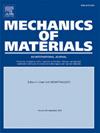Mechanical effects of self-stress states in graphene membranes in multiscale modeling
IF 3.4
3区 材料科学
Q2 MATERIALS SCIENCE, MULTIDISCIPLINARY
引用次数: 0
Abstract
Graphene, an atomically thin material renowned for its exceptional properties, plays a pivotal role in several technological applications. This work elucidates critical aspects of graphene research, particularly focusing on the effects of its transfer onto suitable substrates. Indeed, from the mechanical point of view the transfer process induces self-stresses within the graphene layer. In addition, formidable applications in the field of biosensors, filtration membranes, and special electronic devices are based on precision perforated-graphene. However, perforation introduces localized stress concentrations, altering mechanical behavior and the strength of the graphene membrane.
In this paper, the effects of self-stress states on graphene membrane strength are studied through numerical models. Specifically, the mechanical strength of pristine and perforated graphene membranes subjected to different self-stress states is studied at the nanoscale, using a static molecular mechanics model. Then, a suitably calibrated hyper-elastic continuum model is formulated and correlated with the molecular mechanics model to study the mechanical strength at the micron scale, which is the actual scale of the membranes. Results give important insights on the effects of self-stress states in graphene membranes. We found out also that the interaction distance between holes is strongly influenced by the self-stress state.
石墨烯膜多尺度模型中自应力状态的力学效应
石墨烯是一种原子薄材料,以其独特的性能而闻名,在许多技术应用中发挥着关键作用。这项工作阐明了石墨烯研究的关键方面,特别是关注其转移到合适衬底上的影响。事实上,从力学角度来看,转移过程在石墨烯层内引起了自应力。此外,在生物传感器、过滤膜和特殊电子设备领域的强大应用都是基于精确穿孔的石墨烯。然而,穿孔引入了局部应力集中,改变了石墨烯膜的机械行为和强度。本文通过数值模型研究了自应力状态对石墨烯膜强度的影响。具体来说,在纳米尺度上,使用静态分子力学模型研究了原始和穿孔石墨烯膜在不同自应力状态下的机械强度。在此基础上,建立了经过适当校正的超弹性连续介质模型,并与分子力学模型相关联,在微米尺度(即膜的实际尺度)上研究了膜的机械强度。结果对石墨烯膜中自应力状态的影响提供了重要的见解。我们还发现,孔间的相互作用距离受自应力状态的强烈影响。
本文章由计算机程序翻译,如有差异,请以英文原文为准。
求助全文
约1分钟内获得全文
求助全文
来源期刊

Mechanics of Materials
工程技术-材料科学:综合
CiteScore
7.60
自引率
5.10%
发文量
243
审稿时长
46 days
期刊介绍:
Mechanics of Materials is a forum for original scientific research on the flow, fracture, and general constitutive behavior of geophysical, geotechnical and technological materials, with balanced coverage of advanced technological and natural materials, with balanced coverage of theoretical, experimental, and field investigations. Of special concern are macroscopic predictions based on microscopic models, identification of microscopic structures from limited overall macroscopic data, experimental and field results that lead to fundamental understanding of the behavior of materials, and coordinated experimental and analytical investigations that culminate in theories with predictive quality.
 求助内容:
求助内容: 应助结果提醒方式:
应助结果提醒方式:


